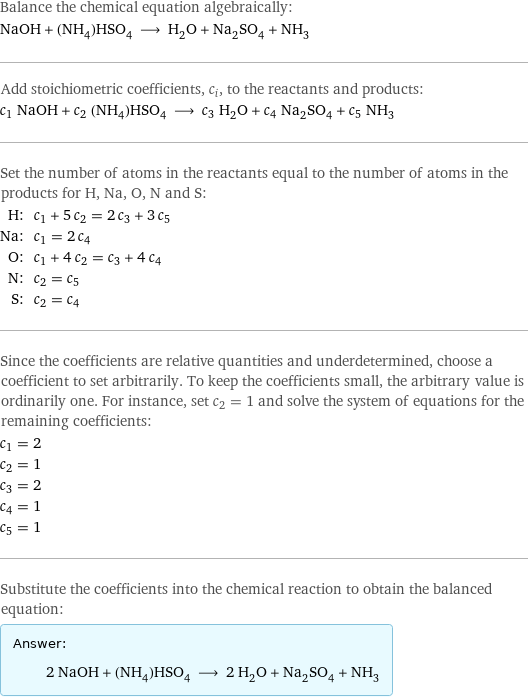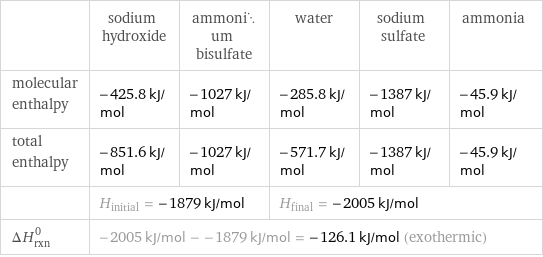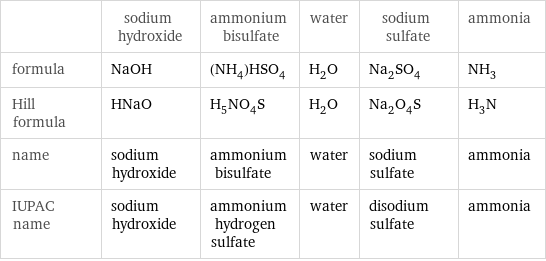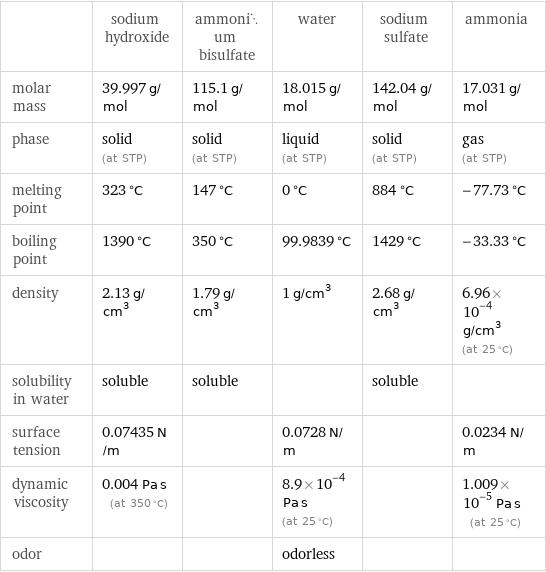Input interpretation

NaOH sodium hydroxide + (NH_4)HSO_4 ammonium bisulfate ⟶ H_2O water + Na_2SO_4 sodium sulfate + NH_3 ammonia
Balanced equation

Balance the chemical equation algebraically: NaOH + (NH_4)HSO_4 ⟶ H_2O + Na_2SO_4 + NH_3 Add stoichiometric coefficients, c_i, to the reactants and products: c_1 NaOH + c_2 (NH_4)HSO_4 ⟶ c_3 H_2O + c_4 Na_2SO_4 + c_5 NH_3 Set the number of atoms in the reactants equal to the number of atoms in the products for H, Na, O, N and S: H: | c_1 + 5 c_2 = 2 c_3 + 3 c_5 Na: | c_1 = 2 c_4 O: | c_1 + 4 c_2 = c_3 + 4 c_4 N: | c_2 = c_5 S: | c_2 = c_4 Since the coefficients are relative quantities and underdetermined, choose a coefficient to set arbitrarily. To keep the coefficients small, the arbitrary value is ordinarily one. For instance, set c_2 = 1 and solve the system of equations for the remaining coefficients: c_1 = 2 c_2 = 1 c_3 = 2 c_4 = 1 c_5 = 1 Substitute the coefficients into the chemical reaction to obtain the balanced equation: Answer: | | 2 NaOH + (NH_4)HSO_4 ⟶ 2 H_2O + Na_2SO_4 + NH_3
Structures

+ ⟶ + +
Names

sodium hydroxide + ammonium bisulfate ⟶ water + sodium sulfate + ammonia
Reaction thermodynamics
Enthalpy

| sodium hydroxide | ammonium bisulfate | water | sodium sulfate | ammonia molecular enthalpy | -425.8 kJ/mol | -1027 kJ/mol | -285.8 kJ/mol | -1387 kJ/mol | -45.9 kJ/mol total enthalpy | -851.6 kJ/mol | -1027 kJ/mol | -571.7 kJ/mol | -1387 kJ/mol | -45.9 kJ/mol | H_initial = -1879 kJ/mol | | H_final = -2005 kJ/mol | | ΔH_rxn^0 | -2005 kJ/mol - -1879 kJ/mol = -126.1 kJ/mol (exothermic) | | | |
Equilibrium constant
![Construct the equilibrium constant, K, expression for: NaOH + (NH_4)HSO_4 ⟶ H_2O + Na_2SO_4 + NH_3 Plan: • Balance the chemical equation. • Determine the stoichiometric numbers. • Assemble the activity expression for each chemical species. • Use the activity expressions to build the equilibrium constant expression. Write the balanced chemical equation: 2 NaOH + (NH_4)HSO_4 ⟶ 2 H_2O + Na_2SO_4 + NH_3 Assign stoichiometric numbers, ν_i, using the stoichiometric coefficients, c_i, from the balanced chemical equation in the following manner: ν_i = -c_i for reactants and ν_i = c_i for products: chemical species | c_i | ν_i NaOH | 2 | -2 (NH_4)HSO_4 | 1 | -1 H_2O | 2 | 2 Na_2SO_4 | 1 | 1 NH_3 | 1 | 1 Assemble the activity expressions accounting for the state of matter and ν_i: chemical species | c_i | ν_i | activity expression NaOH | 2 | -2 | ([NaOH])^(-2) (NH_4)HSO_4 | 1 | -1 | ([(NH4)HSO4])^(-1) H_2O | 2 | 2 | ([H2O])^2 Na_2SO_4 | 1 | 1 | [Na2SO4] NH_3 | 1 | 1 | [NH3] The equilibrium constant symbol in the concentration basis is: K_c Mulitply the activity expressions to arrive at the K_c expression: Answer: | | K_c = ([NaOH])^(-2) ([(NH4)HSO4])^(-1) ([H2O])^2 [Na2SO4] [NH3] = (([H2O])^2 [Na2SO4] [NH3])/(([NaOH])^2 [(NH4)HSO4])](../image_source/ae82c76cc587fa424faa2f69d8ab3c50.png)
Construct the equilibrium constant, K, expression for: NaOH + (NH_4)HSO_4 ⟶ H_2O + Na_2SO_4 + NH_3 Plan: • Balance the chemical equation. • Determine the stoichiometric numbers. • Assemble the activity expression for each chemical species. • Use the activity expressions to build the equilibrium constant expression. Write the balanced chemical equation: 2 NaOH + (NH_4)HSO_4 ⟶ 2 H_2O + Na_2SO_4 + NH_3 Assign stoichiometric numbers, ν_i, using the stoichiometric coefficients, c_i, from the balanced chemical equation in the following manner: ν_i = -c_i for reactants and ν_i = c_i for products: chemical species | c_i | ν_i NaOH | 2 | -2 (NH_4)HSO_4 | 1 | -1 H_2O | 2 | 2 Na_2SO_4 | 1 | 1 NH_3 | 1 | 1 Assemble the activity expressions accounting for the state of matter and ν_i: chemical species | c_i | ν_i | activity expression NaOH | 2 | -2 | ([NaOH])^(-2) (NH_4)HSO_4 | 1 | -1 | ([(NH4)HSO4])^(-1) H_2O | 2 | 2 | ([H2O])^2 Na_2SO_4 | 1 | 1 | [Na2SO4] NH_3 | 1 | 1 | [NH3] The equilibrium constant symbol in the concentration basis is: K_c Mulitply the activity expressions to arrive at the K_c expression: Answer: | | K_c = ([NaOH])^(-2) ([(NH4)HSO4])^(-1) ([H2O])^2 [Na2SO4] [NH3] = (([H2O])^2 [Na2SO4] [NH3])/(([NaOH])^2 [(NH4)HSO4])
Rate of reaction
![Construct the rate of reaction expression for: NaOH + (NH_4)HSO_4 ⟶ H_2O + Na_2SO_4 + NH_3 Plan: • Balance the chemical equation. • Determine the stoichiometric numbers. • Assemble the rate term for each chemical species. • Write the rate of reaction expression. Write the balanced chemical equation: 2 NaOH + (NH_4)HSO_4 ⟶ 2 H_2O + Na_2SO_4 + NH_3 Assign stoichiometric numbers, ν_i, using the stoichiometric coefficients, c_i, from the balanced chemical equation in the following manner: ν_i = -c_i for reactants and ν_i = c_i for products: chemical species | c_i | ν_i NaOH | 2 | -2 (NH_4)HSO_4 | 1 | -1 H_2O | 2 | 2 Na_2SO_4 | 1 | 1 NH_3 | 1 | 1 The rate term for each chemical species, B_i, is 1/ν_i(Δ[B_i])/(Δt) where [B_i] is the amount concentration and t is time: chemical species | c_i | ν_i | rate term NaOH | 2 | -2 | -1/2 (Δ[NaOH])/(Δt) (NH_4)HSO_4 | 1 | -1 | -(Δ[(NH4)HSO4])/(Δt) H_2O | 2 | 2 | 1/2 (Δ[H2O])/(Δt) Na_2SO_4 | 1 | 1 | (Δ[Na2SO4])/(Δt) NH_3 | 1 | 1 | (Δ[NH3])/(Δt) (for infinitesimal rate of change, replace Δ with d) Set the rate terms equal to each other to arrive at the rate expression: Answer: | | rate = -1/2 (Δ[NaOH])/(Δt) = -(Δ[(NH4)HSO4])/(Δt) = 1/2 (Δ[H2O])/(Δt) = (Δ[Na2SO4])/(Δt) = (Δ[NH3])/(Δt) (assuming constant volume and no accumulation of intermediates or side products)](../image_source/9deb897f733b95180c35e0fd03df43ae.png)
Construct the rate of reaction expression for: NaOH + (NH_4)HSO_4 ⟶ H_2O + Na_2SO_4 + NH_3 Plan: • Balance the chemical equation. • Determine the stoichiometric numbers. • Assemble the rate term for each chemical species. • Write the rate of reaction expression. Write the balanced chemical equation: 2 NaOH + (NH_4)HSO_4 ⟶ 2 H_2O + Na_2SO_4 + NH_3 Assign stoichiometric numbers, ν_i, using the stoichiometric coefficients, c_i, from the balanced chemical equation in the following manner: ν_i = -c_i for reactants and ν_i = c_i for products: chemical species | c_i | ν_i NaOH | 2 | -2 (NH_4)HSO_4 | 1 | -1 H_2O | 2 | 2 Na_2SO_4 | 1 | 1 NH_3 | 1 | 1 The rate term for each chemical species, B_i, is 1/ν_i(Δ[B_i])/(Δt) where [B_i] is the amount concentration and t is time: chemical species | c_i | ν_i | rate term NaOH | 2 | -2 | -1/2 (Δ[NaOH])/(Δt) (NH_4)HSO_4 | 1 | -1 | -(Δ[(NH4)HSO4])/(Δt) H_2O | 2 | 2 | 1/2 (Δ[H2O])/(Δt) Na_2SO_4 | 1 | 1 | (Δ[Na2SO4])/(Δt) NH_3 | 1 | 1 | (Δ[NH3])/(Δt) (for infinitesimal rate of change, replace Δ with d) Set the rate terms equal to each other to arrive at the rate expression: Answer: | | rate = -1/2 (Δ[NaOH])/(Δt) = -(Δ[(NH4)HSO4])/(Δt) = 1/2 (Δ[H2O])/(Δt) = (Δ[Na2SO4])/(Δt) = (Δ[NH3])/(Δt) (assuming constant volume and no accumulation of intermediates or side products)
Chemical names and formulas

| sodium hydroxide | ammonium bisulfate | water | sodium sulfate | ammonia formula | NaOH | (NH_4)HSO_4 | H_2O | Na_2SO_4 | NH_3 Hill formula | HNaO | H_5NO_4S | H_2O | Na_2O_4S | H_3N name | sodium hydroxide | ammonium bisulfate | water | sodium sulfate | ammonia IUPAC name | sodium hydroxide | ammonium hydrogen sulfate | water | disodium sulfate | ammonia
Substance properties

| sodium hydroxide | ammonium bisulfate | water | sodium sulfate | ammonia molar mass | 39.997 g/mol | 115.1 g/mol | 18.015 g/mol | 142.04 g/mol | 17.031 g/mol phase | solid (at STP) | solid (at STP) | liquid (at STP) | solid (at STP) | gas (at STP) melting point | 323 °C | 147 °C | 0 °C | 884 °C | -77.73 °C boiling point | 1390 °C | 350 °C | 99.9839 °C | 1429 °C | -33.33 °C density | 2.13 g/cm^3 | 1.79 g/cm^3 | 1 g/cm^3 | 2.68 g/cm^3 | 6.96×10^-4 g/cm^3 (at 25 °C) solubility in water | soluble | soluble | | soluble | surface tension | 0.07435 N/m | | 0.0728 N/m | | 0.0234 N/m dynamic viscosity | 0.004 Pa s (at 350 °C) | | 8.9×10^-4 Pa s (at 25 °C) | | 1.009×10^-5 Pa s (at 25 °C) odor | | | odorless | |
Units
